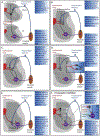Converging integration between ascending proprioceptive inputs and the corticospinal tract motor circuit underlying skilled movement control
- PMID: 33718693
- PMCID: PMC7949357
- DOI: 10.1016/j.cophys.2020.10.007
Converging integration between ascending proprioceptive inputs and the corticospinal tract motor circuit underlying skilled movement control
Abstract
Converging interactions between ascending proprioceptive afferents and descending corticospinal tract projections are critical in the modulation and coordination of skilled motor behaviors. Fundamental to these processes are the functional inputs and the mechanisms of integration in the brain and spinal cord between proprioceptive and corticospinal tract information. In this review, we first highlight key connections between corticospinal tract motor circuit and spinal interneurons that receive proprioceptive inputs. We will also address corticospinal tract access to the presynaptic inhibitory system in the spinal cord and its role in modulating proprioceptive stimuli. Lastly, we will focus on the corticospinal neuron influences on the dorsal column nuclei complex, an integration hub for processing ascending somatosensory information.
Keywords: corticospinal neurons; motor cortex; proprioceptive sensory neurons; spinal cord.
Conflict of interest statement
conflict - review The authors have no competing interests to declare.
Figures


Similar articles
-
Molecular mechanisms underlying monosynaptic sensory-motor circuit development in the spinal cord.Dev Dyn. 2018 Apr;247(4):581-587. doi: 10.1002/dvdy.24611. Epub 2018 Jan 17. Dev Dyn. 2018. PMID: 29226492 Free PMC article. Review.
-
Loss of ETV1/ER81 in motor neurons leads to reduced monosynaptic inputs from proprioceptive sensory neurons.J Neurophysiol. 2023 Jan 25. doi: 10.1152/jn.00172.2022. Online ahead of print. J Neurophysiol. 2023. PMID: 36695533
-
Sensorimotor Integration by Corticospinal System.Front Neuroanat. 2016 Mar 9;10:24. doi: 10.3389/fnana.2016.00024. eCollection 2016. Front Neuroanat. 2016. PMID: 27013985 Free PMC article.
-
Primary motor cortex influences on the descending and ascending systems.Prog Neurobiol. 1997 Feb;51(3):287-335. doi: 10.1016/s0301-0082(96)00058-5. Prog Neurobiol. 1997. PMID: 9089791 Review.
-
Spinal cord maturation and locomotion in mice with an isolated cortex.Neuroscience. 2013 Dec 3;253:235-44. doi: 10.1016/j.neuroscience.2013.08.057. Epub 2013 Sep 4. Neuroscience. 2013. PMID: 24012835
Cited by
-
Pathophysiology of voluntary motor commands at the level of the spinal motoneuron in patients with multiple sclerosis.medRxiv [Preprint]. 2025 Aug 13:2025.08.12.25333527. doi: 10.1101/2025.08.12.25333527. medRxiv. 2025. PMID: 40832417 Free PMC article. Preprint.
-
Gait instability is a more specific predictor of corticospinal tract function than gait speed in clinically stable multiple sclerosis.Sci Rep. 2025 Jul 23;15(1):26822. doi: 10.1038/s41598-025-10830-4. Sci Rep. 2025. PMID: 40702042 Free PMC article.
-
Future spinal reflex is embedded in primary motor cortex output.Sci Adv. 2024 Dec 20;10(51):eadq4194. doi: 10.1126/sciadv.adq4194. Epub 2024 Dec 18. Sci Adv. 2024. PMID: 39693430 Free PMC article.
References
-
- Tuthill JC and Azim E, Proprioception. Curr Biol, 2018. 28(5): p. R194–R203. - PubMed
-
- Lemon RN, Descending pathways in motor control. Annu Rev Neurosci, 2008. 31: p. 195–218. - PubMed
-
- Lemon RN and Griffiths J, Comparing the function of the corticospinal system in different species: organizational differences for motor specialization? Muscle Nerve, 2005. 32(3): p. 261–79. - PubMed
Grants and funding
LinkOut - more resources
Full Text Sources
Other Literature Sources
